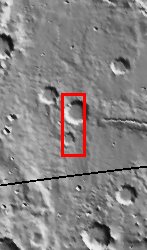
Released 15 September 2003
The Ruza impact crater observed in this THEMIS image taken north of Argyre Planitia shows very interesting gullies and migrating sand dunes. The gullies appear to be more mature and subdued than some previously described gullies and are possibly being covered by a mantle of material. The barchan sand dunes observed in the northern edge of the impact crater are likely migrating up the crater wall as indicated by the crescent shape that points in the wind direction.
Image information: VIS instrument. Latitude -34.2, Longitude 307.2 East (52.8 West). 19 meter/pixel resolution.
Note: this THEMIS visual image has not been radiometrically nor geometrically calibrated for this preliminary release. An empirical correction has been performed to remove instrumental effects. A linear shift has been applied in the cross-track and down-track direction to approximate spacecraft and planetary motion. Fully calibrated and geometrically projected images will be released through the Planetary Data System in accordance with Project policies at a later time.
NASA's Jet Propulsion Laboratory manages the 2001 Mars Odyssey mission for NASA's Office of Space Science, Washington, D.C. The Thermal Emission Imaging System (THEMIS) was developed by Arizona State University, Tempe, in collaboration with Raytheon Santa Barbara Remote Sensing. The THEMIS investigation is led by Dr. Philip Christensen at Arizona State University. Lockheed Martin Astronautics, Denver, is the prime contractor for the Odyssey project, and developed and built the orbiter. Mission operations are conducted jointly from Lockheed Martin and from JPL, a division of the California Institute of Technology in Pasadena.

